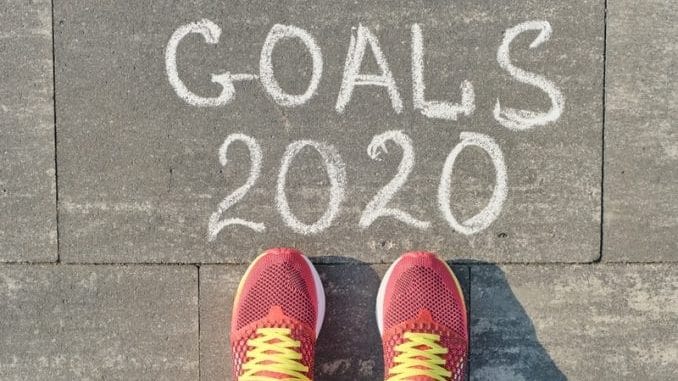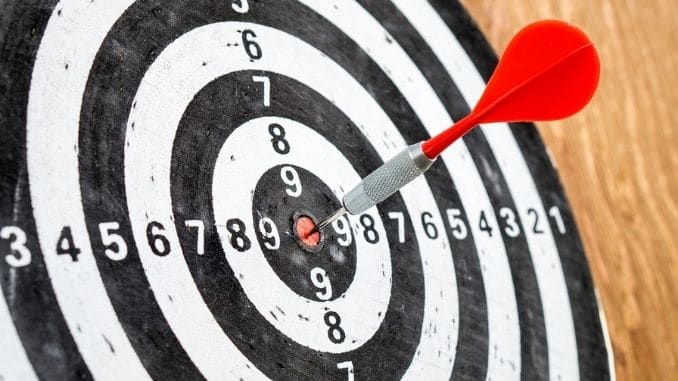
Have you given up on setting goals for the New Year?
Many people have for one big reason — they don’t work. Studies have indicated that less than 25 percent of people remain committed to their New Year’s resolutions after only 30 days. A dismal 8 percent are said to follow through on those resolutions throughout the year.
Faced with such discouraging statistics, it’s no wonder many people have decided setting goals for the New Year is a useless endeavor. Unfortunately, not setting goals is usually even worse.
Not setting goals can also lead to discouragement and a lack of confidence in time. You may feel like you don’t know where you’re going, which can leave you feeling a little lost. You are less likely to accomplish new things, which can chip away at your confidence and self-esteem. Your motivation may slowly seep out of you, and you might begin to think that what you do doesn’t matter.
Business magnate and philanthropist Andrew Carnegie was quoted as saying, “If you want to be happy, set a goal that commands your thoughts, liberates your energy and inspires your hopes.”
Research shows that Carnegie was right. In one recent study of nearly 1,000 participants between the ages of 18 and 92, scientists found that people who set goals they believed were attainable reported higher cognitive, mental, and emotional well-being during a period of two years. Interestingly enough, the actual attainment of those goals wasn’t as relevant as how the people felt about going after them.
The authors concluded that it’s the feeling of control over one’s life that matters most, and goals can help us gain that feeling.
If you’ve given up on goals because they haven’t worked for you in the past, we have some ideas for how you might approach them a bit differently for the coming New Year. It turns out the problem isn’t setting goals, but what kind of goals we set.
1. Break Up Your Year
One of the biggest drawbacks with traditional goals or New Year’s resolutions is that a year is way too long to wait to celebrate an achievement. Although there’s nothing wrong with having a long-term vision for where you want to go, we all need checkpoints along the way, or we lose our motivation.
When setting your goals this year, focus on the short-term as well as the long-term. You can do that easily by breaking up your year. Instead of setting one giant goal for the entire year, set four goals for each quarter, six goals for every two months, or even 12 goals ― one for each month.
Short-term goals offer you a series of milestones that help keep you going toward your ultimate goal. They provide a way to work hard for a short time, then achieve something, after which you enjoy the reward of that achievement or even a reward that you give yourself for getting there. The reward is what the brain lives for.
Immediate rather than delayed rewards inspire us to achieve. In a 2016 study, researchers found that immediate rewards predicted persistence at New Year’s resolutions, whereas delayed rewards did not.
Even if you’re pursuing long-term goals — you want to lose 20 pounds by the end of the year, for example — providing yourself with more immediate rewards along the way will increase your motivation and make it more likely that you’ll persist toward your long-term goal.
Put It In Practice
Go ahead and set your long-term goal for the year, but then break it down into smaller milestones. If you want to adopt an overall healthier diet, for example, perhaps you can break it down into these four milestones:
- Milestone 1, by April 1: Reduce consumption of added sugars. By March 1, consume no more than one soda per week and three sweet desserts. The rest of the time, drink water, milk, tea, and coffee and enjoy fruit for dessert.
- Milestone 2, by July 1: Add more vegetables to my diet. By July 1, have dinner recipes that fill most of the plate with vegetables and increase daily vegetable intake to at least five servings per day.
- Milestone 3, by October 1: Reduce consumption of processed foods. By October 1, be happy with homemade snacks like yogurt and granola, cut-up veggies and fruits, whole-grain bread and peanut butter, and so on, and eliminate processed snacks like potato chips.
- Milestone 4, by December 31: Reduce consumption of red meat. By December 31, be enjoying more evening meals that have fish, chicken, and pork as the main protein source, or even some vegetarian proteins. Limit red meat to no more than once a week.
No matter what your end goal is, you can break it down into steps like these — or even more steps — and then set up rewards for yourself to celebrate each milestone. Some examples might include a nice dinner out with your loved ones, a new gadget or tool for your kitchen, or a picnic with your friends.
2. Set Process Goals
Another reason we often fail at achieving our goals is that we focus too much on the outcome — losing 20 pounds — and not enough on how we’re going to get there. How will you lose those 20 pounds?
If all you do is say, “I’m going to lose 20 pounds by the end of the year,” that’s a great goal, but it’s unlikely to be successful because you haven’t given yourself a process to follow. We need to know what we’re going to do on a daily basis if we’re going to get where we want to go.
That means after you decide what it is you want this year, you have to break it down into how you’re going to do it. Simply put, this is about setting new habits. What habits do you need to adopt to reach your goal?
Write those down. Your list may look something like this:
- I’ll exercise for 30 minutes a day at least five days a week.
- I’ll stop eating after 9 p.m. and won’t eat again until breakfast.
- I’ll eat my meals much slower to allow my brain to register that I’m full.
- I’ll drink more water, particularly before meals.
- I’ll weigh myself every Wednesday and Saturday morning.
Now you have some definite habits you can now work to develop — you have a process to follow. The more specific you can get, the higher your chances of success. For example, we may specify the five steps further above like this:
- I’ll jog for 30 minutes Monday and Wednesday right after work, head to the gym for weightlifting Tuesdays and Thursdays before work and enjoy a nice long walk after work on Fridays after work.
- I’ll stop eating after 9 p.m. and won’t eat again until breakfast. On those nights when I have strong cravings, I’ll fix myself a cup of flavored tea, or allow myself a quarter-cup of healthy, whole-grain cereal.
- I’ll eat my meals much more slowly to allow my brain to register that I’m full. I’ll check the clock and make sure that I’m taking at least 20 minutes for breakfast and lunch, and at least 30 for dinner.
- I’ll drink more water, particularly before meals. I’ll keep a chart and track how many glasses I have per day, with a goal of eight.
- I’ll weigh myself every Wednesday and Saturday morning, and mark my results on a chart, providing myself with a reward for every three pounds lost and kept off for at least two weeks.
You can see that the more specific you get, the more you know exactly what to do, and the higher your odds of achieving your long-term goal.
3. Set Minimum, Target, and Inspired Short-term Goals
No matter how good your intentions, life is going to interfere with your new habits somewhere along the way. There are going to be days when you just can’t fit in that 30 minutes of exercise, or you have to rush through a meal.
These sorts of setbacks can diminish your motivation to the point where you start slacking off on your new habits. To avoid that outcome, break your short-term goals into three forms: minimum, target and inspired. Base these three forms on what you want to accomplish and where you are at the start.
For example, if you’re already exercising 30 minutes a day, it probably won’t be too hard to continue doing that most of the time. However, if you’re not exercising hardly at all, then some days that 30 minutes is going to feel impossible. Here’s where the three forms can help.
Let’s use the first example from above: exercising 30 minutes a day.
- Minimum goal: 10 minutes of exercise
- Target goal: 30 minutes of exercise
- Inspired goal: 45 minutes of exercise
When you break down your goal in this way, you know what you’re going for, but on those days when life is crazy, you can still hit your minimum goal. This does several good things for you — it keeps you going forward, keeps you motivated and helps you feel that at least you accomplished something, which is much better than nothing.
This sort of approach is more likely to help you succeed as you keep moving forward no matter what, which helps you build momentum toward that long-term goal.
With each of your short-term goals, break them down into these three forms, then keep those in mind as you go about adopting your new habits.
Try a New Approach to Goal-setting
No matter what sort of goals or resolutions you’re thinking about for the new year — losing weight, getting more fit, saving more money, eating healthier, learning a new skill or starting a side business — using these three newer approaches can help you succeed.
Give it a try. You may be pleasantly surprised at what you can accomplish.
For help keeping your New Year’s goals, make sure to check out The Best Foods that Rapidly Slim & Heal, here!
.






